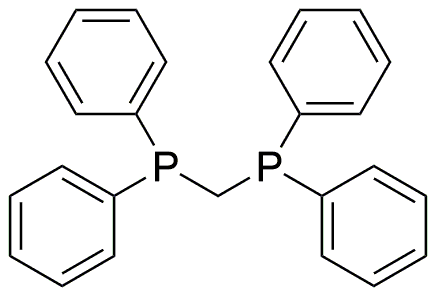Bis(diphenylphosphino)methane is widely utilized in research focused on:
- Catalysis: This compound serves as a highly effective ligand in various catalytic processes, particularly in transition metal-catalyzed reactions, enhancing reaction rates and selectivity.
- Organometallic Chemistry: It plays a crucial role in the synthesis of organometallic complexes, which are essential for developing new materials and pharmaceuticals.
- Pharmaceutical Development: The compound is used in drug discovery for its ability to stabilize metal ions, aiding in the design of new therapeutic agents.
- Polymer Chemistry: It is applied in the production of advanced polymers, improving properties like thermal stability and mechanical strength.
- Environmental Chemistry: This chemical is involved in research aimed at developing catalysts for environmental remediation, helping to reduce pollutants effectively.
General Information
Properties
Safety and Regulations
Applications
Bis(diphenylphosphino)methane is widely utilized in research focused on:
- Catalysis: This compound serves as a highly effective ligand in various catalytic processes, particularly in transition metal-catalyzed reactions, enhancing reaction rates and selectivity.
- Organometallic Chemistry: It plays a crucial role in the synthesis of organometallic complexes, which are essential for developing new materials and pharmaceuticals.
- Pharmaceutical Development: The compound is used in drug discovery for its ability to stabilize metal ions, aiding in the design of new therapeutic agents.
- Polymer Chemistry: It is applied in the production of advanced polymers, improving properties like thermal stability and mechanical strength.
- Environmental Chemistry: This chemical is involved in research aimed at developing catalysts for environmental remediation, helping to reduce pollutants effectively.
Documents
Safety Data Sheets (SDS)
The SDS provides comprehensive safety information on handling, storage, and disposal of the product.
Product Specification (PS)
The PS provides a comprehensive breakdown of the product’s properties, including chemical composition, physical state, purity, and storage requirements. It also details acceptable quality ranges and the product's intended applications.
Certificates of Analysis (COA)
Search for Certificates of Analysis (COA) by entering the products Lot Number. Lot and Batch Numbers can be found on a product’s label following the words ‘Lot’ or ‘Batch’.
*Catalog Number
*Lot Number
Certificates Of Origin (COO)
This COO confirms the country where the product was manufactured, and also details the materials and components used in it and whether it is derived from natural, synthetic, or other specific sources. This certificate may be required for customs, trade, and regulatory compliance.
*Catalog Number
*Lot Number
Safety Data Sheets (SDS)
The SDS provides comprehensive safety information on handling, storage, and disposal of the product.
DownloadProduct Specification (PS)
The PS provides a comprehensive breakdown of the product’s properties, including chemical composition, physical state, purity, and storage requirements. It also details acceptable quality ranges and the product's intended applications.
DownloadCertificates of Analysis (COA)
Search for Certificates of Analysis (COA) by entering the products Lot Number. Lot and Batch Numbers can be found on a product’s label following the words ‘Lot’ or ‘Batch’.
*Catalog Number
*Lot Number
Certificates Of Origin (COO)
This COO confirms the country where the product was manufactured, and also details the materials and components used in it and whether it is derived from natural, synthetic, or other specific sources. This certificate may be required for customs, trade, and regulatory compliance.


